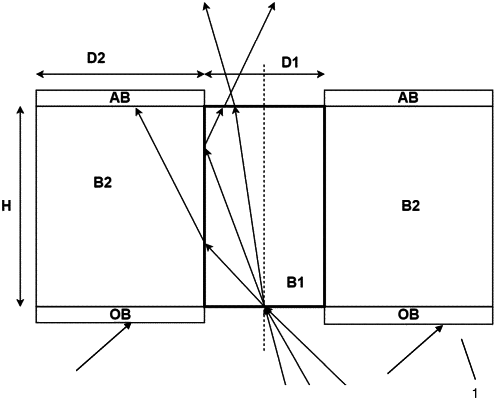| CPC G02F 1/1306 (2013.01) [G02B 26/005 (2013.01); G02F 1/1341 (2013.01); G02F 1/13439 (2013.01); G02F 1/13471 (2013.01); G02F 1/15 (2013.01); G02F 1/167 (2013.01); G02B 2207/115 (2013.01); G02F 1/133788 (2013.01)] | 22 Claims |

|
1. A two-dimensionally extensive optical element having a light entry side and a light exit side, comprising:
first regions comprising a first transparent material with a first refractive index and second regions comprising a second transparent material with a second refractive index which alternate over a surface of the first optical element in a one-dimensional or two-dimensional periodic sequence, wherein the first refractive index is higher than the second refractive index within an entire wavelength range visible to the human eye,
in each instance, a first layer at a light entry surface of each of the second regions, which first layer is permanently opaque or is switchable between a transparent state and an opaque state,
in each instance, a second layer at a light exit surface of each of the second regions, which second layer is permanently opaque or is switchable between a transparent state and an opaque state,
wherein either every first layer or every second layer, or every first layer and every second layer, is permanently opaque,
such that, owing to the first layers, light impinging on the optical element on the light entry side is incident in the optical element exclusively through the light entry surfaces of the first regions when the first layers are in an opaque state and, depending on the incident angle, polarization and the ratio of the first refractive index to the second refractive index:
a) is propagated unimpeded or is totally internally reflected inside of a first region and is thereafter coupled out again at a light exit surface of the corresponding first region, or
b) penetrates from the first region into an adjoining second region, propagates in the latter and is ultimately absorbed at the light exit side thereof when the second layer is in the opaque state or is coupled out when the second layer is in the transparent state, or
c) when the light has penetrated from the first region into the adjoining second region, penetrates in turn into a further, adjacent, first region and, depending on the propagation direction and polarization which then exist, is coupled out at the light exit surface or propagated further in the optical element until it is either coupled out or absorbed,
as a result of which, the propagation directions of the light exiting from the optical element at the light exit side are limited compared to the light impinging on the optical element at the light entry side insofar as at least the first layer and/or the second layer is opaque,
wherein every first layer is formed at the light entry surfaces of the second regions by a permanent absorber layer and/or by at least one layer reflecting away from the optical element, and/or
every second layer is formed at the light exit surface of the second regions by a permanent absorber layer.
|